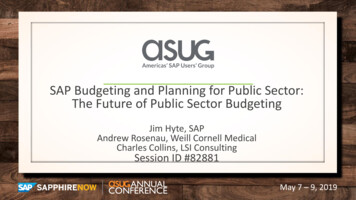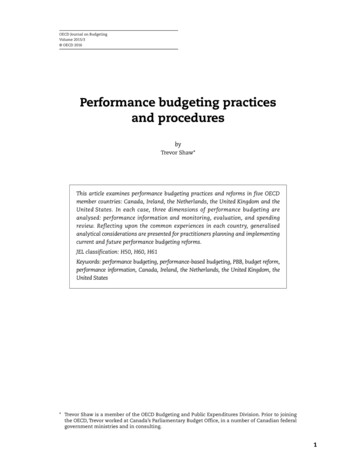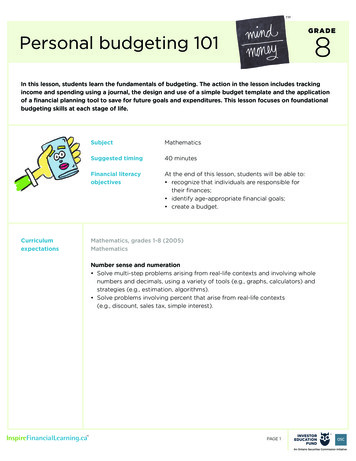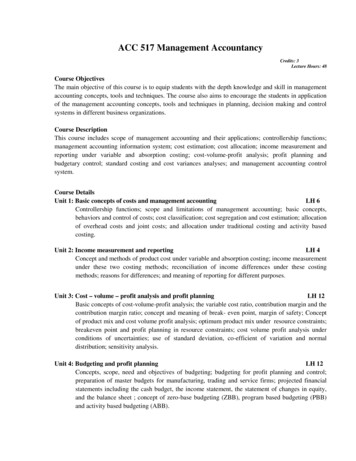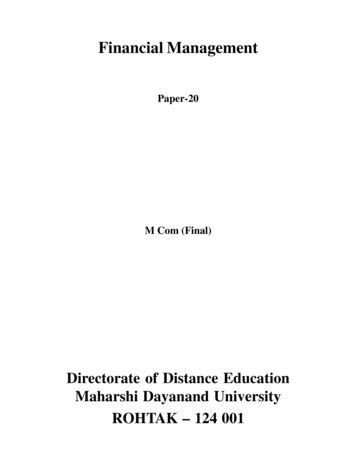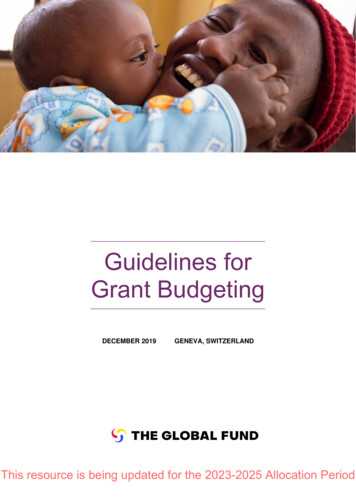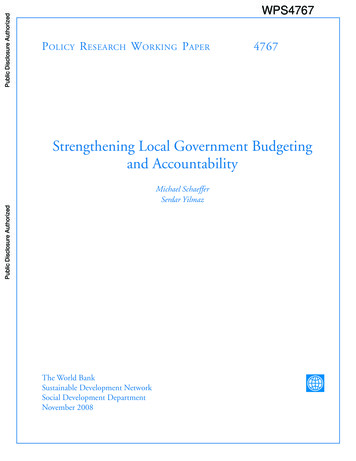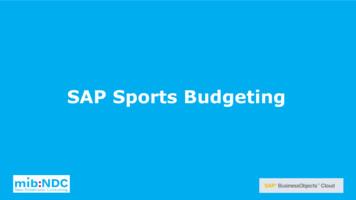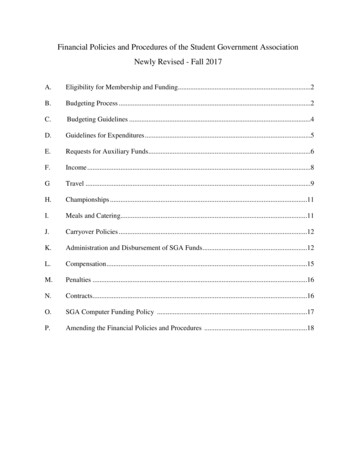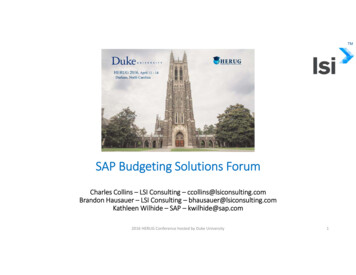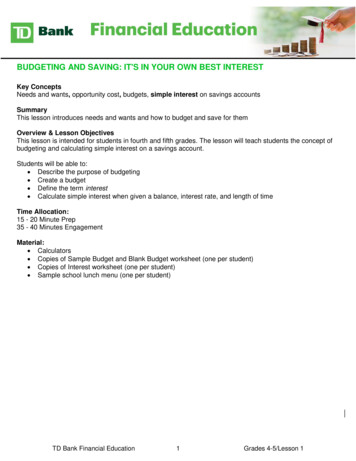
Transcription
BUDGETING AND SAVING: IT'S IN YOUR OWN BEST INTERESTKey ConceptsNeeds and wants, opportunity cost, budgets, simple interest on savings accountsSummaryThis lesson introduces needs and wants and how to budget and save for themOverview & Lesson ObjectivesThis lesson is intended for students in fourth and fifth grades. The lesson will teach students the concept ofbudgeting and calculating simple interest on a savings account.Students will be able to: Describe the purpose of budgeting Create a budget Define the term interest Calculate simple interest when given a balance, interest rate, and length of timeTime Allocation:15 - 20 Minute Prep35 - 40 Minutes EngagementMaterial: Calculators Copies of Sample Budget and Blank Budget worksheet (one per student) Copies of Interest worksheet (one per student) Sample school lunch menu (one per student)TD Bank Financial Education1Grades 4-5/Lesson 1
Lesson Begins: Setting the StageBackground Builder #1: Instruct students to make a t-chart on the back of the Interest Worksheet. Or youcan make a t-chart on the board (see below)NeedsWants1.2.3.4.5.1.2.3.4.5.Ask students to define needs and define wants. Select several students. Remind them that a need issomething that we must have to survive, and a want is something we would like to have. Ask the students toname needs and wants and write them down on the board. Discuss the results with the class. Ask studentsto think of ways that they can get what they need and want (i.e. working and saving). Finally, tell studentsthat saving is a good thing, and a plan or budget will help them achieve their goal and guarantee financialsuccess.State the Objective: tell the students what they will be able to do upon conclusion of the lesson.“At the end of this lesson, you will understand the purpose of budgeting and be able to create your own. Youwill also be able to calculate simple interest.”Lesson ContinuesBudgeting is the process of making your needs and wants fit. It can be difficult at times, but it is the key tomaking sure you have your money under control.Review attached sample budget with students to demonstrate and clarify concepts. Allow students to work inpairs with a calculator and pencil to complete the attached budget worksheet.Provide the following scenario:You expect to receive 100 each month as an allowance. Use your calculator and school lunch menu todetermine how much money you would need to buy lunch at school every day.Allow students to use the sample budget worksheet.It is difficult to go to school without pencils, paper and other supplies. Even if your school or teacher givesyou most of your supplies, there are items you will need or want to buy. Maybe you buy gel pens,highlighters, and glue sticks. Gel pens cost on average 5.95, highlighters cost 3.50, and glue sticks cost 2.50. How much will you need for school supplies this month? (Answer: 11.95)TD Bank Financial Education2Grades 4-5/Lesson 1
Allow students to work and write the correct answer on the budget sheet. Below are some sample purchasesto say out loud? Is this a week when you are going to a birthday party? You will need to buy a gift.Is there a new movie that you want to see?Is there a video game that you really want?Add the following amounts together to see how much your other expenses will be. Let's say you buya birthday gift for 20.You went to the movies twice this month, and each time you bought a ticket you spent 10.00. Youbought popcorn one time and it cost 4.50.There is a new video game you want that costs 21.99.What is your expense total for these categories?You may have to write these amounts on the board in order to help the students record them correctly.(Answer: 66.49 - 41.99 for Entertainment, 20.00 for Gifts, 4.50 Snacks). Allow students to copy thecorrect answer onto the budget sheet.How much did you spend of your allowance? How can we figure that out?Allow students to add the totals for each category. Allow students to add the totals together and then call onsomeone to give an answer.If we want to know how much is left over from our original 100 a month allowance, what do we need to do?Subtract expenses from income. Your savings for this month would be what is left. When you look at howyou spend your money, you should recognize that you have control over meeting your expenses. If you wantto start saving more money, what spending habit could you change from this budget?Allow students to offer suggestions such as packing a lunch a few days a month, going to the movies onlyonce, foregoing the video game, etc.A bank is the safest place to keep your money, and because people let us protect their money, banks giveyou back what is called interest. Interest is money that you earn just by having money in a savings account.It is a percent of the total amount of money that you keep in a bank. The interest rate, the length of time andthe amount of money in your account determines the amount of interest you will receive from the bank.For example, if you save 100 for one year in an account with a 1% interest rate you would have earned 1.00 from the bank.Write 0.01 on the board. Model how you arrived at this answer via the chalkboard and by using the calculatorfor computation.Lesson ClosesAsk students to clarify between needs and wants and how a budget can help them achieve their goals. Elicitfrom students that saving money in the bank is not only safe but also profitable because they will earninterest. See next page for additional ideas to end the lesson.TD Bank Financial Education3Grades 4-5/Lesson 1
Additional Engagement Opportunities / ResourcesPair and ShareStudents (pairs) interview one another about the lesson content. They must summarize the partner’sfeedback in either written report or verbal formatSample Questions: What did you learn during today's lesson? What are some expenses you may currently have? What types of earnings do you gather? Define interestQuizbowlSeparate the students into two or three teams and ask questions related to the lesson.Sample Questions: What item would you be willing to save money for in order to make the purchase? Where do you expect to get the money you’ll save? How much spending money will be available? Are there items you’ll need to forego in order to save enough money? How long will it take you to save enough money for the item you desire? Student generated questions should also be encouraged in place of or in addition to the ones listedabove.Storyboard/Stretch to SketchStudents write and illustrate a storyboard which is a piece of paper folded into six or eight squares. Eachsquare is filled with a picture and caption. The story should be an example of how saving could be useful ineach student’s life.TD Bank Financial Education4Grades 4-5/Lesson 1
Money TriviaThe following are miscellaneous facts about money that you may wish to include in your presentation. Theymay also be helpful in answering questions the students have: About 3,500 years ago Cowrie shells (small seashells) were used for money in China, Africa, andAustralia. The Yap Islanders in the Pacific Ocean used large stone disks about 13 feet across for money. (Thisis about as long as a chalkboard.) China used bricks of tea leaves for money until just 100 years ago. The Roman soldiers earned their wages in an allowance of salt, called a salarium. This is where theword salary originates. Coins last about 20 or 30 years in circulation before they are worn out. 1, 5, 10, and 20 bills lastabout 3 months. Then they are shredded and burned by special people in the government. 50 and 100 bills can last for 3 or 4 years. Do you know who is pictured on our currency?Thomas Jefferson 2 – Two DollarsAlexander Hamilton 10 – Ten DollarsUlysses S. Grant 50 – Fifty DollarsWilliam McKinley 500 – Five Hundred DollarsGeorge Washington 1 - One DollarAbraham Lincoln 5 – Five DollarsAndrew Jackson 20 – Twenty DollarsBenjamin Franklin 100 – One Hundred DollarsTD Bank Financial Education5Grades 4-5/Lesson 1
Educational StandardsNational Council of Teachers of Mathematics Principles and Standards for School Mathematics, 2000: Number and Operations – (Students will) Understand numbers, ways of representing numbers,relationships among numbers, and number systems. Number and Operations – (Students will) Compute fluently and make reasonable estimates.Connections – (Students will) Recognize and use connections among mathematical ideas.Representation – (Students will) Create and use representations to organize, record, and communicatemathematical ideasNJ Core Curriculum Content Standards in Personal Financial Literacy 2014:Standard 9.1: 21st Century Life and Careers 9.1 B. Money Management: 9.1.4.B.1, 9.1.4.B.2, 9.1.4.B.3, 9.1.4.B.4 9.1 C. Credit and Debt Management: 9.1.4.C.4 9.1 D. Planning, Saving, and Investing: 9.1.4.D.2 9.1 E. Becoming a Critical Consumer: 9.1.4.E.1, 9.1.4.E.2National Standards in K – 12 Personal Finance Education (from Jump tart Coalition) 2017:Financial Decision Making: Standard 4, “Make criterion-based decisions by systematically considering alternatives andconsequences.” Spending and Saving : Standard 1, “Develop a plan for spending and saving.” Standard 4, “Apply consumer skills to spending and saving decisions.”Investing: Standard 1, “Explain how investing may build wealth and help meet financial goals." Standard 2, “Evaluate investment alternatives.”National Content Standards in Economics,(from Council for Economic Education) 2010:Content Standard 1, ScarcityTD Bank Financial Education6Grades 4-5/Lesson 1
Interest WorksheetName:Date:Use the formula I PRT to solve the following problems.1. John received 100 as a gift from his grandparents for his elementary school graduation. He decided tosave it in the bank until he decided what he would do with the money. The interest rate on his savingsaccount is 1.5%. How much interest will he earn the first year?2. Nicole received a check for 50 when she won a local essay contest. Her mother told her to save it forcollege. If it earns interest at a rate of 1%, how much money will Nicole have after one year?3. When Mary’s new baby sister was born, her relatives gave her 25 to start a savings account. How muchwill Mary’s sister have when she turns 1 if her money is kept in the bank earning 1% interest?4. Eduardo earned 520 over the year for doing chores around the house. He decided to take 200 to thebank where it will earn 1.5% interest. How much interest will he earn if he leaves it there for 1 year?5. When Lori and Jeff got married, they put 1,000 of their gifts into a savings account in the hopes ofpurchasing a bigger home sometime in the future. If they get a rate of 2%, how much will they have towardtheir home in 1 year?TD Bank Financial Education7Grades 4-5/Lesson 1
Interest worksheet answer keyUse the formula I PRT to solve the following problems.1. John received 100 as a gift from his grandparents for his elementary school graduation. He decided tosave it in the bank until he decided what he would do with the money. The interest rate on his savingsaccount is 1.5%. How much interest will he earn the first year? 1.502. Nicole received a check for 50 when she won a local essay contest. Her mother told her to save it forcollege. If it earns interest at a rate of 1%, how much money will Nicole have after one year? 50.503. When Mary’s new baby sister was born, her relatives gave her 25 to start a savings account. How muchwill Mary’s sister have when she turns 1 if her money is kept in the bank earning 1% interest? 25.254. Eduardo earned 520 over the year for doing chores around the house. He decided to take 200 to thebank where it will earn 1.5% interest. How much interest will he earn if he leaves it there for 1 year? 3.005. When Lori and Jeff got married, they put 1,000 of their gifts into a savings account in the hopes ofpurchasing a bigger home sometime in the future. If they get a rate of 2%, how much will they have towardtheir home in 1 year? 1,020.00TD Bank Financial Education8Grades 4-5/Lesson 1
Monthly budget worksheetThe following is an example of a monthly budget. You can use it to refer to as you plan your own budget.INCOME/MONEY RECEIVEDEarnings: 20.00Allowance: 10.00Gifts: 25.00Other: 0.00TOTAL: 55.00EXPENSES/MONEY SPENTSnacks/Lunch: 20.00School Supplies: 5.00Gifts Bought: 7.50Entertainment: 12.00TOTAL: 44.50EXCESS/MONTHLY TOTALIncome:Expenses: 55.00-TOTAL (Savings): 44.50 10.50TD Bank Financial Education9Grades 4-5/Lesson 1
Blank Monthly budget worksheetThe following is monthly budget worksheet. You can use it as you plan your own budget.INCOME/MONEY SES/MONEY SPENTSnacks/Lunch:School Supplies:Gifts Bought:Entertainment :TOTAL:EXCESS/MONTHLY TOTALIncome:Expenses:-TOTAL (Savings):TD Bank Financial Education10Grades 4-5/Lesson 1
Sample Lunch riday's 2.00 3.00 2.00 3.00 2.00TD Bank Financial Education11Grades 4-5/Lesson 1
Define the term interest Calculate simple interest when given a balance, interest rate, and length of time Time Allocation: 15 - 20 Minute Prep 35 - 40 Minutes Engagement . you back what is called interest. Interest is money that you earn just by having money in a savings account. It is a percent of the total amount of money that you keep in .
